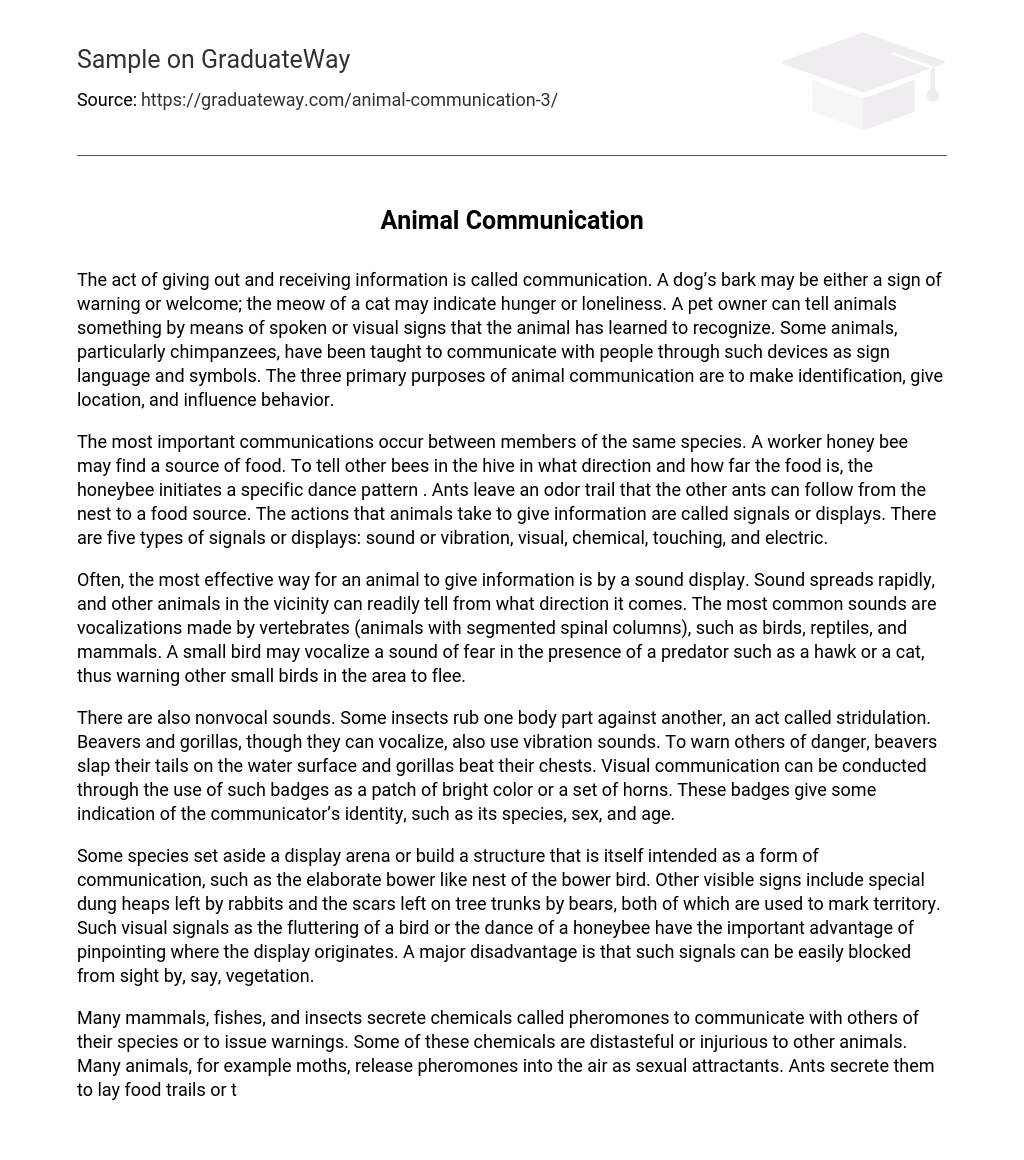The act of giving out and receiving information is called communication. A dog’s bark may be either a sign of warning or welcome; the meow of a cat may indicate hunger or loneliness. A pet owner can tell animals something by means of spoken or visual signs that the animal has learned to recognize. Some animals, particularly chimpanzees, have been taught to communicate with people through such devices as sign language and symbols. The three primary purposes of animal communication are to make identification, give location, and influence behavior.
The most important communications occur between members of the same species. A worker honey bee may find a source of food. To tell other bees in the hive in what direction and how far the food is, the honeybee initiates a specific dance pattern . Ants leave an odor trail that the other ants can follow from the nest to a food source. The actions that animals take to give information are called signals or displays. There are five types of signals or displays: sound or vibration, visual, chemical, touching, and electric.
Often, the most effective way for an animal to give information is by a sound display. Sound spreads rapidly, and other animals in the vicinity can readily tell from what direction it comes. The most common sounds are vocalizations made by vertebrates (animals with segmented spinal columns), such as birds, reptiles, and mammals. A small bird may vocalize a sound of fear in the presence of a predator such as a hawk or a cat, thus warning other small birds in the area to flee.
There are also nonvocal sounds. Some insects rub one body part against another, an act called stridulation. Beavers and gorillas, though they can vocalize, also use vibration sounds. To warn others of danger, beavers slap their tails on the water surface and gorillas beat their chests. Visual communication can be conducted through the use of such badges as a patch of bright color or a set of horns. These badges give some indication of the communicator’s identity, such as its species, sex, and age.
Some species set aside a display arena or build a structure that is itself intended as a form of communication, such as the elaborate bower like nest of the bower bird. Other visible signs include special dung heaps left by rabbits and the scars left on tree trunks by bears, both of which are used to mark territory. Such visual signals as the fluttering of a bird or the dance of a honeybee have the important advantage of pinpointing where the display originates. A major disadvantage is that such signals can be easily blocked from sight by, say, vegetation.
Many mammals, fishes, and insects secrete chemicals called pheromones to communicate with others of their species or to issue warnings. Some of these chemicals are distasteful or injurious to other animals. Many animals, for example moths, release pheromones into the air as sexual attractants. Ants secrete them to lay food trails or to warn the ant colony of danger. The disadvantage of pheromones is the rapid fading of the odor, making them an inadequate means of communication in situations that may change rapidly.
Pheromone effectiveness is also considerably decreased in wind and rain. Some species of animals, especially birds and mammals, use touching patterns to convey information. Birds and monkeys often engage in mutual grooming that seems to communicate acceptance. Wolves, dogs, and other canines have mock fights to establish and reestablish dominance and rank in a pack. A few species of fishes can emit electrical discharge patterns as part of a sensory system intended to gather information about surroundings and to fend off predators.
Similarly, bats, dolphins, and porpoises have a sonar scanning system to enable them to perceive the environment without necessarily seeing it. Displays intended to convey or influence behavior are frequently more ambiguous or tentative in their nature than other kinds of signals. The snarling of a dog may indicate intention to attack or simply fear on the dog’s part. A male spider, intending to mate with its partner, will strum on her web rather than face the danger of moving into the web too rapidly. Some animals, even of the same species, may signal the desire to escape or to attack.





